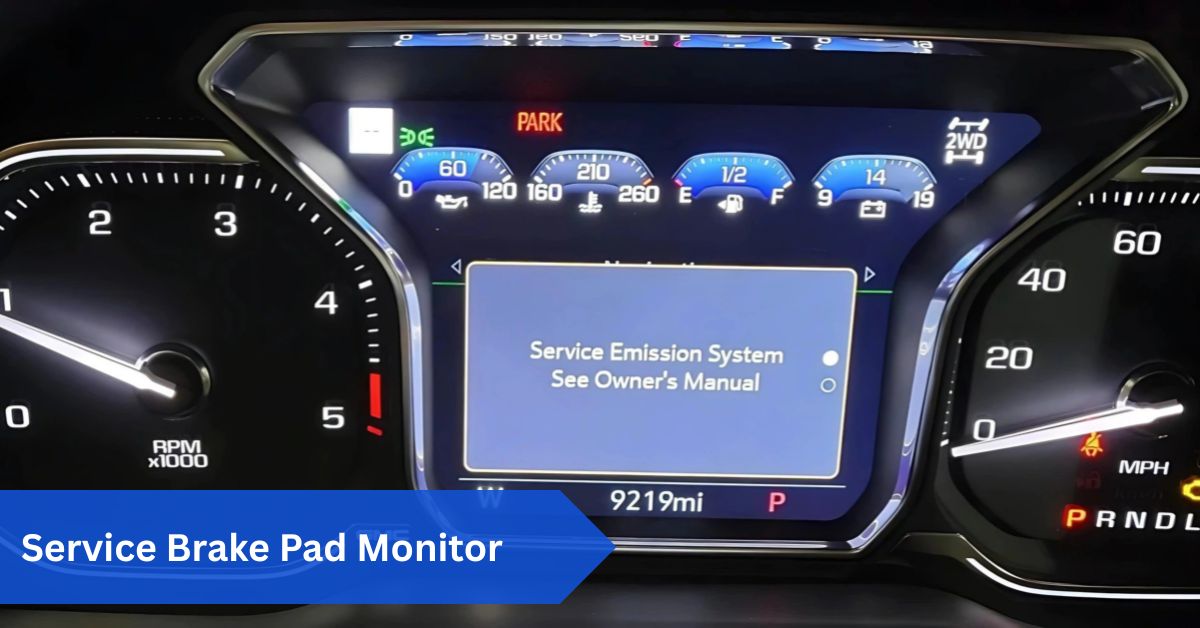Introduction to Service Brake Pad Monitor:
When you push the brake pedal, you may be sure that your car will stop quickly and safely. However, because the braking system mostly relies on brake pads, which deteriorate with time, it is not indestructible.
A service brake pad monitor is a sensor system that tracks brake pad wear and alerts drivers when replacement is needed, helping prevent accidents, costly repairs, and reduced braking performance. It ensures safer driving by keeping your braking system reliable at all times.
In addition to being annoying, driving with worn-out brake pads is dangerous. Because of this, contemporary cars come with a service brake pad monitor, a device that monitors brake pad condition and warns you before things get dangerous. Imagine it as a digital assistant that continuously inspects one of your car’s most crucial parts.
In This Article, we discuss “Service Brake Pad Monitor”.
Why Brake Pad Monitoring Matters:
Brake pads are essential for slowing down and stopping your car fully. Over time, friction wears them out. Driving on thin pads means longer stopping distances, poor control, and, in worst cases, complete brake failure.
Brake pad monitors are designed to prevent this by ensuring drivers know when pads are reaching their limits. Without monitoring, most people only notice issues when it’s too late, which can lead to expensive repairs—or worse, accidents.
The Role of Technology in Vehicle Safety:
Cars are smarter than ever, with features like adaptive cruise control, lane departure warnings, and collision prevention. Brake pad monitors belong to this family of technologies, acting as a safety net that warns you before your braking system becomes unreliable.
With electronic sensors, software integration, and predictive alerts, they’ve transformed what used to be a manual guesswork job into an automated, precise process.
Understanding Brake Pad Monitors:
What is a Service Brake Pad Monitor?
A service brake pad monitor is a sensor-based system designed to measure brake pad wear and notify the driver when maintenance is required. Instead of waiting for squealing noises or sluggish braking, the system provides real-time updates on pad health. It’s like having a built-in mechanic that constantly evaluates one of your car’s most critical systems.
How Brake Pad Monitors Work:
The system works by embedding small sensors in or near the brake pads. The sensors are activated when the pad material deteriorates. In basic systems, this simply activates a dashboard light.
In more complex configurations, the system estimates the amount of wear, forecasts the remaining distance, and even sends an alarm via a connected app. The process is seamless, happening in the background every time you drive.
Types of Brake Pad Monitoring Systems:
Mechanical Indicators:
These are the most basic types of surveillance. A tiny metal tab on the brake pad makes a screaming noise when it wears down to a particular degree because it scratches against the rotor. Despite being low-tech, this method is dependable and difficult to overlook.
Electronic Sensors:
Electronic brake pad sensors use wires embedded in the pads. As the pads thin, the circuit breaks, sending a signal to the car’s computer system, which then displays a warning on the dashboard. This method is more precise than mechanical indicators.
Advanced Smart Monitoring:
High-end cars now use advanced sensors that not only detect wear but also analyze driving patterns. These systems estimate how many miles remain before service is needed and may connect with mobile apps or dealership software to schedule maintenance automatically.
Importance of Service Brake Pad Monitors:

Enhancing Road Safety:
The most obvious argument in favor of brake pad monitoring is safety. It is more difficult to prevent accidents when stopping distances are longer due to worn-out pads. Monitors make sure you continue to brake at your best by warning you.
Preventing Costly Repairs:
Complete pad wear can cause damage to the brake calipers and rotors. Replacing the rotors is actually more expensive than replacing the pads. Monitors encourage prompt replacement, preventing such expensive situations.
Boosting Vehicle Performance:
Healthy brake pads enhance handling during abrupt stops in addition to improving stopping power. Monitors ensure you’re never caught driving with subpar braking power, keeping your vehicle responsive in emergencies.
Signs That Trigger Brake Pad Monitoring Alerts:
Common Dashboard Warnings:
When the monitor detects thin pads, a brake warning light or “service brake pad” message will appear on your dashboard. This is how your car lets you know when new pads are needed.
Unusual Sounds and Vibrations:
Sometimes the monitor isn’t the first sign—you might hear squealing, grinding, or feel vibrations when braking. All of these symptoms are about to be triggered by the monitor.
Reduced Braking Efficiency:
If your car takes longer to stop or the brake pedal feels spongy, the monitor will likely alert you soon. These signs show that the pads are considerably worn down.
How Service Brake Pad Monitors Help Drivers:
Real-Time Alerts and Notifications:
Instead of guessing when to replace pads, you get timely alerts that eliminate uncertainty.
Predictive Maintenance Insights:
Advanced systems can estimate future wear, allowing you to plan service around your schedule rather than waiting for an emergency.
Extending Brake System Lifespan:
By catching wear early, monitors protect other braking components like rotors and calipers, extending the overall system’s life.
Service Brake Pad Monitor Installation and Functionality:

How Manufacturers Integrate Sensors:
In most modern cars, sensors are pre-installed by manufacturers. They are embedded directly in the brake pad material or positioned close enough to detect wear levels.
Compatibility with Modern Cars:
Nearly all new vehicles—especially mid-range and luxury models—come with some form of brake pad monitoring. The manufacturer determines the degree of sophistication, though.
Upgrading Older Vehicles with Monitors:
For cars without built-in systems, aftermarket options are available. These may not be as advanced as factory systems, but they still provide a useful safety net.
Common Issues with Brake Pad Monitors:
False Alarms and Sensor Malfunctions:
Sometimes monitors trigger alerts too early, causing unnecessary concern. This may happen due to sensor placement or electrical glitches.
Software Calibration Problems:
If the vehicle’s onboard computer isn’t properly calibrated, it may misread sensor data. Regular maintenance helps avoid these errors.
Environmental Impact on Sensors:
Extreme temperatures, road debris, and water exposure can interfere with sensor performance, especially in electronic systems.
Maintenance Tips for Brake Pad Monitors:
Regular Sensor Checks:
During routine services, ask your mechanic to test whether the brake pad sensors are working correctly.
Cleaning and Calibration:
Brake systems collect dust and dirt. Sensor accuracy is maintained during brake servicing by cleaning them.
When to Replace Monitoring Systems:
If sensors fail repeatedly or show inaccurate readings, replacing them is more cost-effective than ignoring faulty data.
Benefits of Using Brake Pad Monitoring Systems:

Peace of Mind for Drivers:
Knowing your car constantly monitors brake health gives you confidence on long trips and in heavy traffic.
Improved Vehicle Resale Value:
Cars with fully functional monitoring systems are more attractive to buyers because they signal proper care and safety.
Contribution to Sustainable Driving:
Efficient brake maintenance reduces waste by preventing premature damage to other components, which contributes to sustainability.
Future of Brake Pad Monitoring Technology:
Integration with AI and IoT:
Future monitors will connect with smart ecosystems, sending real-time data to apps, mechanics, and even insurance providers.
Smart Vehicle Ecosystems:
In the near future, your car could sync with service centers, order parts, and book maintenance appointments automatically when pads wear down.
Predictive AI for Brake Health:
Artificial intelligence may soon predict pad wear not just based on mileage but also on your driving style, road conditions, and braking habits.
Conclusion:
The service brake pad monitor is one of those quiet heroes of modern driving. While it may not be as flashy as a touch screen display or a self-parking system, it plays a critical role in keeping you safe on the road.
Monitoring brake pad wear prevents accidents, saves money on repairs, and extends the life of your vehicle. Whether you drive a brand-new car with an advanced smart system or an older model with a basic warning light, brake pad monitoring ensures you’re always in control.
With technology evolving rapidly, we can expect even smarter systems that predict wear long before problems arise. At the end of the day, the service brake pad monitor isn’t just about convenience—it’s about peace of mind every time you hit the road.
FAQs:
1. What does a service brake pad monitor warning mean?
It indicates that your brake pads have worn down and need replacement soon to maintain safe braking performance. Addressing the issue promptly prevents further wear on the braking system and ensures driver safety.
2. Can I keep driving with a brake pad monitor alert on?
Yes, but only for a short time. Ignoring the warning can lead to unsafe braking and potential damage to your rotors. It’s best to schedule a brake inspection as soon as the warning appears to avoid costly repairs.
3. How often should brake pad monitors be inspected?
They should be checked during routine maintenance, usually every six to twelve months, depending on driving habits. Frequent highway driving or heavy braking may require earlier inspections.
4. Do all modern cars have brake pad monitors?
Most vehicles today are equipped with them, while luxury models often feature more advanced predictive monitoring systems. These systems give drivers peace of mind by alerting them before braking performance is compromised.
5. What is the cost to repair or replace a brake pad monitoring system?
The price varies by vehicle, but replacement sensors typically range from $50 to $150, depending on complexity. Labor costs can add to the total, so checking during routine service may help save money.
